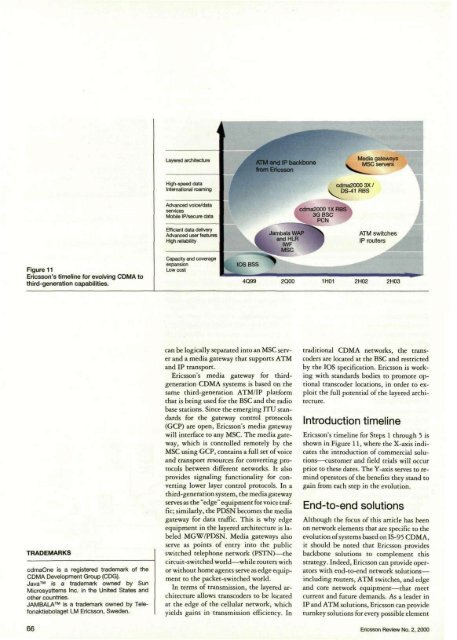ericssonhistory.com
ericssonhistory.com
ericssonhistory.com
- No tags were found...
You also want an ePaper? Increase the reach of your titles
YUMPU automatically turns print PDFs into web optimized ePapers that Google loves.
Figure 11Ericsson's timeline for evolving CDMA tothird-generation capabilities.TRADEMARKScdmaOne is a registered trademark of theCDMA Development Group (CDG).Java is a trademark owned by SunMicrosysttems Inc. in the United States andother countries.JAMBALA is a trademark owned by TelefonaktiebolagetLM Ericsson, Sweden.can be logically separated into an MSC serverand a media gateway that supports ATMand IP transport.Ericsson's media gateway for thirdgenerationCDMA systems is based on thesame third-generation ATM/IP platformthat is being used for the BSC and the radiobase stations. Since the emerging ITU standardsfor the gateway control protocols(GCP) are open, Ericsson's media gatewaywill interface to any MSC. The media gateway,which is controlled remotely by theMSC using GCP, contains a full set of voiceand transport resources for converting protocolsbetween different networks. It alsoprovides signaling functionality for convertinglower layer control protocols. In athird-generation system, the media gatewayserves as the "edge" equipment for voice traffic;similarly, the PDSN be<strong>com</strong>es the mediagateway for data traffic. This is why edgeequipment in the layered architecture is labeledMGW/PDSN. Media gateways alsoserve as points of entry into the publicswitched telephone network (PSTN)—thecircuit-switched world—while routers withor without home agents serve as edge equipmentto the packet-switched world.In terms of transmission, the layered architectureallows transcoders to be locatedat the edge of the cellular network, whichyields gains in transmission efficiency. Intraditional CDMA networks, the transcodersare located at the BSC and restrictedby the IOS specification. Ericsson is workingwith standards bodies to promote optionaltranscoder locations, in order to exploitthe full potential of the layered architecture.Introduction timelineEricsson's timeline for Steps 1 through 5 isshown in Figure 11, where the X-axis indicatesthe introduction of <strong>com</strong>mercial solutions—customerand field trials will occurprior to these dates. The Y-axis serves to remindoperators of the benefits they stand togain from each step in the evolution.End-to-end solutionsAlthough the focus of this article has beenon network elements that are specific to theevolution of systems based on IS-95 CDMA,it should be noted that Ericsson providesbackbone solutions to <strong>com</strong>plement thisstrategy. Indeed, Ericsson can provide operatorswith end-to-end network solutions—including routers, ATM switches, and edgeand core network equipment—that meetcurrent and future demands. As a leader inIP and ATM solutions, Ericsson can provideturnkey solutions for every possible element66 Ericsson Review No. 2, 2000















